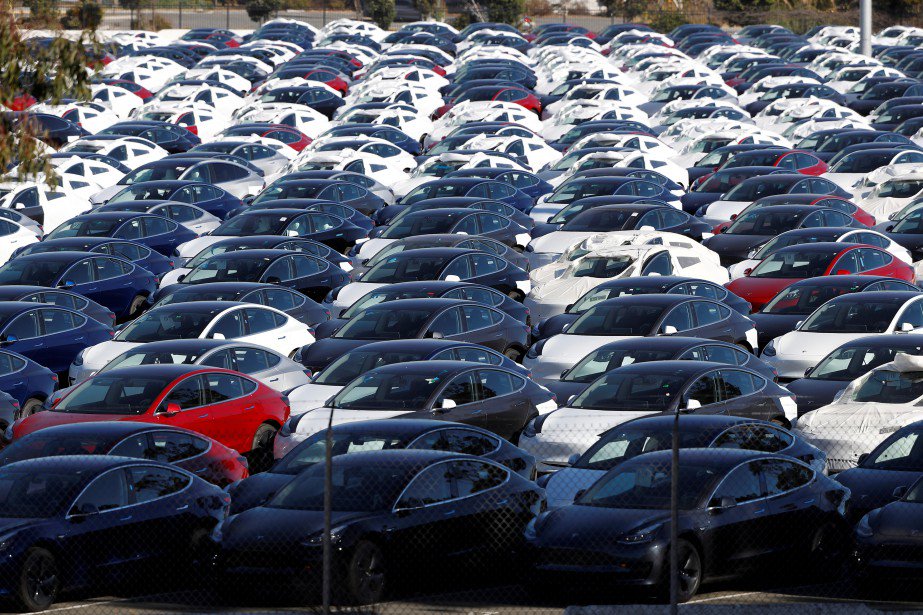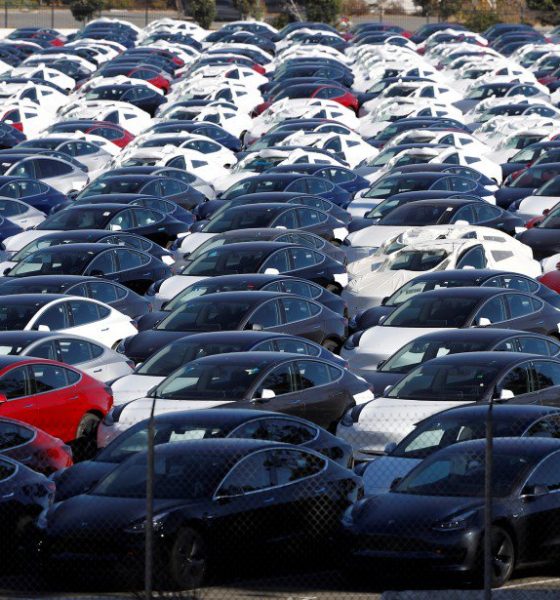

News
Tesla shares timelapse video of busy Fremont factory lot during Model 3’s final Q2 push
Tesla shared a rare glimpse inside the Fremont factory’s outbound logistics lot during the final week of Q2 2018 — the week when the electric carmaker finally achieved its target of producing 5,000 Model 3 per week. As could be seen in the short timelapse video, Tesla worked around the clock to achieve its goal, with the outbound lot seeing a flurry of activity during the week of June 24.
Particularly notable in the short video was the quick turnover rate of the vehicles that were filling up the outbound logistics lot day in and day out. The timelapse also depicted the consistent stream of delivery trucks hauling vehicles away as soon as the vehicles were rolled out into the lot.
Fremont outbound logistics lot, week of June 24th pic.twitter.com/fUPASRrTBd
— Tesla (@Tesla) July 3, 2018
Tesla’s 5,000/week milestone for Model 3 production was teased Saturday night by some employees at the Fremont factory, and later confirmed by Elon Musk himself in a leaked email. According to Musk, Tesla was not only able to manufacture 5,000 Model 3 during the final week of June; it was also able to sustain the 2,000/week production rate for the Model S &X and produce a total of 7,000 vehicles in 7 days.
The Model 3’s production milestone did not come easy for the electric car manufacturer, however. When Tesla started deliveries for the Model 3 last July, Musk estimated that the company would be able to attain a production rate of 5,000 vehicles per week by the end of December 2017. Due to several production bottlenecks, however, Tesla failed to achieve its goal. The company eventually moved the 5,000/week Model 3 production target to the end of Q2 2018, while placing a target of 2,500 vehicles per week for the end of Q1 2018.
Both Tesla and Musk himself had to dig deep in order to achieve its Q2 2018 production targets for the Model 3. During the quarter, Tesla enacted a 10-day production shutdown for the vehicle in order to make way for additional equipment to be installed on the Model 3 line. Back in May, Tesla also opted to air-freight six airplanes’ worth of robots and equipment from Europe to the United States. A company-wide restructuring was enacted as well, resulting in Telsa trimming off 9% of its workforce. Just like the Model X days, the serial tech entrepreneur and CEO began sleeping on the factory floor, in order to address any issues in the Model 3 line in real-time.
Most importantly, however, Tesla also built the Model 3’s newest assembly line inside a sprung structure set up on the grounds of the Fremont factory. This additional line enabled Tesla to augment its manufacturing capabilities, with the company stating in its Q2 delivery and production that around 20% of Model 3 produced during the June 24 week were assembled inside GA4.
Apart from achieving its self-imposed Model 3 targets, Tesla’s recent moves are also aimed at achieving profitability by Q3 or Q4 2018. According to Musk, it is high time for Tesla to become profitable, especially since most of the pieces are already in place for the company to successfully scale the production of the Model 3. With Tesla now targeting a pace equivalent to 6,000 Model 3 per week, the company is now edging closer to its goal of being profitable.

News
Tesla is not sparing any expense in ensuring the Cybercab is safe
Images shared by the longtime watcher showed 16 Cybercab prototypes parked near Giga Texas’ dedicated crash test facility.

The Tesla Cybercab could very well be the safest taxi on the road when it is released and deployed for public use. This was, at least, hinted at by the intensive safety tests that Tesla seems to be putting the autonomous two-seater through at its Giga Texas crash test facility.
Intensive crash tests
As per recent images from longtime Giga Texas watcher and drone operator Joe Tegtmeyer, Tesla seems to be very busy crash testing Cybercab units. Images shared by the longtime watcher showed 16 Cybercab prototypes parked near Giga Texas’ dedicated crash test facility just before the holidays.
Tegtmeyer’s aerial photos showed the prototypes clustered outside the factory’s testing building. Some uncovered Cybercabs showed notable damage and one even had its airbags engaged. With Cybercab production expected to start in about 130 days, it appears that Tesla is very busy ensuring that its autonomous two-seater ends up becoming the safest taxi on public roads.
Prioritizing safety
With no human driver controls, the Cybercab demands exceptional active and passive safety systems to protect occupants in any scenario. Considering Tesla’s reputation, it is then understandable that the company seems to be sparing no expense in ensuring that the Cybercab is as safe as possible.
Tesla’s focus on safety was recently highlighted when the Cybertruck achieved a Top Safety Pick+ rating from the Insurance Institute for Highway Safety (IIHS). This was a notable victory for the Cybertruck as critics have long claimed that the vehicle will be one of, if not the, most unsafe truck on the road due to its appearance. The vehicle’s Top Safety Pick+ rating, if any, simply proved that Tesla never neglects to make its cars as safe as possible, and that definitely includes the Cybercab.
Elon Musk
Tesla’s Elon Musk gives timeframe for FSD’s release in UAE
Provided that Musk’s timeframe proves accurate, FSD would be able to start saturating the Middle East, starting with the UAE, next year.

Tesla CEO Elon Musk stated on Monday that Full Self-Driving (Supervised) could launch in the United Arab Emirates (UAE) as soon as January 2026.
Provided that Musk’s timeframe proves accurate, FSD would be able to start saturating the Middle East, starting with the UAE, next year.
Musk’s estimate
In a post on X, UAE-based political analyst Ahmed Sharif Al Amiri asked Musk when FSD would arrive in the country, quoting an earlier post where the CEO encouraged users to try out FSD for themselves. Musk responded directly to the analyst’s inquiry.
“Hopefully, next month,” Musk wrote. The exchange attracted a lot of attention, with numerous X users sharing their excitement at the idea of FSD being brought to a new country. FSD (Supervised), after all, would likely allow hands-off highway driving, urban navigation, and parking under driver oversight in traffic-heavy cities such as Dubai and Abu Dhabi.
Musk’s comments about FSD’s arrival in the UAE were posted following his visit to the Middle Eastern country. Over the weekend, images were shared online of Musk meeting with UAE Defense Minister, Deputy Prime Minister, and Dubai Crown Prince HH Sheikh Hamdan bin Mohammed. Musk also posted a supportive message about the country, posting “UAE rocks!” on X.
FSD recognition
FSD has been getting quite a lot of support from foreign media outlets. FSD (Supervised) earned high marks from Germany’s largest car magazine, Auto Bild, during a test in Berlin’s challenging urban environment. The demonstration highlighted the system’s ability to handle dense traffic, construction sites, pedestrian crossings, and narrow streets with smooth, confident decision-making.
Journalist Robin Hornig was particularly struck by FSD’s superior perception and tireless attention, stating: “Tesla FSD Supervised sees more than I do. It doesn’t get distracted and never gets tired. I like to think I’m a good driver, but I can’t match this system’s all-around vision. It’s at its best when both work together: my experience and the Tesla’s constant attention.” Only one intervention was needed when the system misread a route, showcasing its maturity while relying on vision-only sensors and over-the-air learning.
News
Tesla quietly flexes FSD’s reliability amid Waymo blackout in San Francisco
“Tesla Robotaxis were unaffected by the SF power outage,” Musk wrote in his post.

Tesla highlighted its Full Self-Driving (Supervised) system’s robustness this week by sharing dashcam footage of a vehicle in FSD navigating pitch-black San Francisco streets during the city’s widespread power outage.
While Waymo’s robotaxis stalled and caused traffic jams, Tesla’s vision-only approach kept operating seamlessly without remote intervention. Elon Musk amplified the clip, highlighting the contrast between the two systems.
Tesla FSD handles total darkness
The @Tesla_AI account posted a video from a Model Y operating on FSD during San Francisco’s blackout. As could be seen in the video, streetlights, traffic signals, and surrounding illumination were completely out, but the vehicle drove confidently and cautiously, just like a proficient human driver.
Musk reposted the clip, adding context to reports of Waymo vehicles struggling in the same conditions. “Tesla Robotaxis were unaffected by the SF power outage,” Musk wrote in his post.
Musk and the Tesla AI team’s posts highlight the idea that FSD operates a lot like any experienced human driver. Since the system does not rely on a variety of sensors and a complicated symphony of factors, vehicles could technically navigate challenging circumstances as they emerge. This definitely seemed to be the case in San Francisco.
Waymo’s blackout struggles
Waymo faced scrutiny after multiple self-driving Jaguar I-PACE taxis stopped functioning during the blackout, blocking lanes, causing traffic jams, and requiring manual retrieval. Videos shared during the power outage showed fleets of Waymo vehicles just stopping in the middle of the road, seemingly confused about what to do when the lights go out.
In a comment, Waymo stated that its vehicles treat nonfunctional signals as four-way stops, but “the sheer scale of the outage led to instances where vehicles remained stationary longer than usual to confirm the state of the affected intersections. This contributed to traffic friction during the height of the congestion.”
A company spokesperson also shared some thoughts about the incidents. “Yesterday’s power outage was a widespread event that caused gridlock across San Francisco, with non-functioning traffic signals and transit disruptions. While the failure of the utility infrastructure was significant, we are committed to ensuring our technology adjusts to traffic flow during such events,” the Waymo spokesperson stated, adding that it is “focused on rapidly integrating the lessons learned from this event, and are committed to earning and maintaining the trust of the communities we serve every day.”








